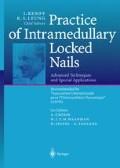Zusammenfassung
Der Begriff Acne venenata (venenum = Gift) faßt eine Gruppe von Sonderformen der Acne vulgaris mit ähnlicher Ätiologie zusammen.
Access this chapter
Tax calculation will be finalised at checkout
Purchases are for personal use only
Preview
Unable to display preview. Download preview PDF.
Literatur
Andersen K (1986) Testing of cosmetics and toiletries. Acta Physiol Scand 554 (suppl.): 180–190.
Anonymous (1989) American Academy of Dermatology invitational symposium on comedogenicity. J Am Acad Dermatol 20: 272–277.
Cunliffe WJ (1993) Akne. Klinik, Differentialdiagnose, Pathogenese, Therapie. Übersetzt durch Gollnick HPM und Orfanos CE, Hippokrates, Stuttgart.
Fulton JE Jr, Pay SR, Fulton JE (1984) Comedogenicity of current therapeutic products, cosmetics, and ingredients in the rabbit ear. J Am Acad Dermatol 10: 96–105.
Goulden V, ClarkSM, Cunliffe WJ (1997) Post-adolescent acne: a review of clinical features. Br J Dermatol 136: 66–70.
Kligman AM (1991) Postadolescent acne in women. Cutis 48: 75–77.
Kligman AM, Mills OH (1972) »Acne cosmetica«. Arch Dermatol 106: 843–850.
Kligman AM, Kwong T (1979) An improved rabbit ear model for assessing comedogenic substances. Br J Dermatol 100: 699–702.
Mills OH, Kligman AM (1982) A human model for assessing comedogenic substances. Arch Dermatol 118: 903–905.
Mills OH, Berger RS (1991) Defining the susceptibility of acne-prone and sensitive skin populations to extrinsic factors. Dermatol Clin 9: 93–98.
Nelson FP, Rumsfield J (1988) Cosmetics. Content and function. Int J Dermatol 27: 665–672.
Orfanos CE, Garbe C (1995) Therapie der Hautkrankheiten. Springer Verlag, Berlin.
Plewig G, Kligman AM (1978) Akne. Pathogenese, Morphologie, Therapie. Springer, Berlin.
Plewig G, Fulton JE, Kligman AM (1970) Pomade Acne. Arch Dermatol 101: 580–584.
Tucker SB, Flannigan SA, Dunbar M, Drotman RB (1986) Development of an objective comedogenic assay. Arch Dermatol 122: 660–665.
Editor information
Editors and Affiliations
Rights and permissions
Copyright information
© 2000 Springer-Verlag Berlin Heidelberg
About this paper
Cite this paper
Zouboulis, C.C. (2000). Acne venenata und Acne cosmetica. In: Braun-Falco, O., Gloor, M., Korting, H.C. (eds) Nutzen und Risiko von Kosmetika. Springer, Berlin, Heidelberg. https://doi.org/10.1007/978-3-642-59747-3_13
Download citation
DOI: https://doi.org/10.1007/978-3-642-59747-3_13
Publisher Name: Springer, Berlin, Heidelberg
Print ISBN: 978-3-642-64108-4
Online ISBN: 978-3-642-59747-3
eBook Packages: Springer Book Archive

